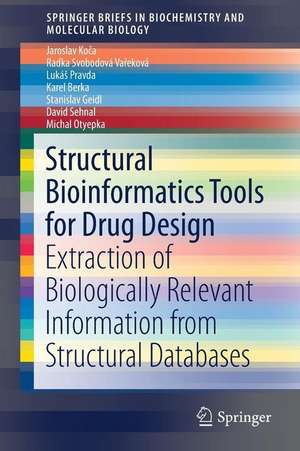Structural Bioinformatics Tools for Drug Design: Extraction of Biologically Relevant Information from Structural Databases: SpringerBriefs in Biochemistry and Molecular Biology
Autor Jaroslav Koča, Radka Svobodová Vařeková, Lukáš Pravda, Karel Berka, Stanislav Geidl, David Sehnal, Michal Otyepkaen Limba Engleză Paperback – feb 2017
The book describes the individual steps necessary for biomacromolecular fragments analysis, as well as a list of essential software tools. For each step, it also shows corresponding web-based tools in detail and provides practical examples of their use.
All tools and databases mentioned in the examples are available free of charge, platform-independent, web-based, user-friendly and do not require a prior IT background to be fully used.
All tools and databases mentioned in the examples are available free of charge, platform-independent, web-based, user-friendly and do not require a prior IT background to be fully used.
Din seria SpringerBriefs in Biochemistry and Molecular Biology
-
 Preț: 384.48 lei
Preț: 384.48 lei -
 Preț: 311.31 lei
Preț: 311.31 lei - 5%
 Preț: 359.21 lei
Preț: 359.21 lei - 5%
 Preț: 359.21 lei
Preț: 359.21 lei - 5%
 Preț: 360.14 lei
Preț: 360.14 lei -
 Preț: 377.18 lei
Preț: 377.18 lei -
 Preț: 375.23 lei
Preț: 375.23 lei - 5%
 Preț: 359.60 lei
Preț: 359.60 lei -
 Preț: 375.23 lei
Preț: 375.23 lei -
 Preț: 376.22 lei
Preț: 376.22 lei -
 Preț: 377.57 lei
Preț: 377.57 lei - 5%
 Preț: 358.32 lei
Preț: 358.32 lei -
 Preț: 375.23 lei
Preț: 375.23 lei -
 Preț: 442.44 lei
Preț: 442.44 lei - 5%
 Preț: 358.11 lei
Preț: 358.11 lei - 5%
 Preț: 327.88 lei
Preț: 327.88 lei - 5%
 Preț: 514.96 lei
Preț: 514.96 lei -
 Preț: 378.71 lei
Preț: 378.71 lei -
 Preț: 380.84 lei
Preț: 380.84 lei -
 Preț: 346.86 lei
Preț: 346.86 lei -
 Preț: 374.85 lei
Preț: 374.85 lei -
 Preț: 409.63 lei
Preț: 409.63 lei -
 Preț: 375.07 lei
Preț: 375.07 lei - 5%
 Preț: 357.61 lei
Preț: 357.61 lei -
 Preț: 374.30 lei
Preț: 374.30 lei - 5%
 Preț: 361.06 lei
Preț: 361.06 lei
Preț: 413.45 lei
Nou
Puncte Express: 620
Preț estimativ în valută:
79.12€ • 85.92$ • 66.46£
79.12€ • 85.92$ • 66.46£
Carte tipărită la comandă
Livrare economică 22 aprilie-06 mai
Preluare comenzi: 021 569.72.76
Specificații
ISBN-13: 9783319473871
ISBN-10: 3319473875
Pagini: 162
Ilustrații: XIII, 144 p. 62 illus.
Dimensiuni: 155 x 235 x 26 mm
Greutate: 0.23 kg
Ediția:1st ed. 2016
Editura: Springer International Publishing
Colecția Springer
Seria SpringerBriefs in Biochemistry and Molecular Biology
Locul publicării:Cham, Switzerland
ISBN-10: 3319473875
Pagini: 162
Ilustrații: XIII, 144 p. 62 illus.
Dimensiuni: 155 x 235 x 26 mm
Greutate: 0.23 kg
Ediția:1st ed. 2016
Editura: Springer International Publishing
Colecția Springer
Seria SpringerBriefs in Biochemistry and Molecular Biology
Locul publicării:Cham, Switzerland
Cuprins
1. Introduction.- 2. Biomacromolecular fragments .- 3. Databases.- 4. Detection & Extraction.- a. Biomacromolecular fragments and structural patterns.- b. channels and pores.- 5. Validation.- 6. Characterization.- a. Partial atomic charges.- b. Channel characteristics.- 7. Selected Examples.
Notă biografică
Prof. RNDr. Jaroslav Koca, DrSc., is director of the Central European Institute of Technology and Head of the research group Computational Chemistry at Masaryk University in Brno, Czech Republic.
His field of expertise is mathematical and computer assisted chemistry and biochemistry, computer assisted molecular modeling of biologically interesting chemical species, information technology in chemistry, biochemistry, and environmental chemistry. Last years´ projects were mainly on conformational search, molecular docking and molecular dynamics simulations on peptides, proteins, oligonucleotides, nucleotide sugars, and carbohydrates. Methods for analysis conformational potential energy surfaces and energy landscapes of chemical reactions using molecular mechanics and quantum chemistry techniques. For more information see: http://www.chemi.muni.cz/~jkoca/
His field of expertise is mathematical and computer assisted chemistry and biochemistry, computer assisted molecular modeling of biologically interesting chemical species, information technology in chemistry, biochemistry, and environmental chemistry. Last years´ projects were mainly on conformational search, molecular docking and molecular dynamics simulations on peptides, proteins, oligonucleotides, nucleotide sugars, and carbohydrates. Methods for analysis conformational potential energy surfaces and energy landscapes of chemical reactions using molecular mechanics and quantum chemistry techniques. For more information see: http://www.chemi.muni.cz/~jkoca/
Textul de pe ultima copertă
A large amount of structural data on biomacromolecules is available and the number of resolved structures is growing rapidly. This implies that we have an increasing opportunity to perform so far unprecedented analyses to obtain crucial biological insight. Biomacromolecular structural fragments such as binding sites or active sites, ligands, channels, pores, secondary structure motifs, etc., become very promising objects for these analyses because such fragments often serve as drug targets or drug templates, or substrate-specific pathways.
However, such analyses are very challenging due to their complexity and, consequently, also because they require application of a combination of different software tools. In this book, we describe individual steps necessary for analysis of biomacromolecular fragments and provide a lsit of software tools required to perform such steps. For each step, we also show corresponding web-based tools in detail and provide a few practical examples oftheir usage.
However, such analyses are very challenging due to their complexity and, consequently, also because they require application of a combination of different software tools. In this book, we describe individual steps necessary for analysis of biomacromolecular fragments and provide a lsit of software tools required to perform such steps. For each step, we also show corresponding web-based tools in detail and provide a few practical examples oftheir usage.
Caracteristici
Presents an overview of key steps in the analysis of biomacromolecular fragments and a corresponding list of current software tools for each step of the analysis. Provides detailed descriptions of selected software tools for individual steps including practical examples of their application (hands-on experience). Provides a thorough description of a molecular language for defining biomacromolecular fragments Includes a detailed description of how such a language can be integrated in the software used for biomacromolecular fragments. Features biologically relevant examples of the whole workflow for the fragment analysis (task definition - Includes supplementary material: sn.pub/extras
